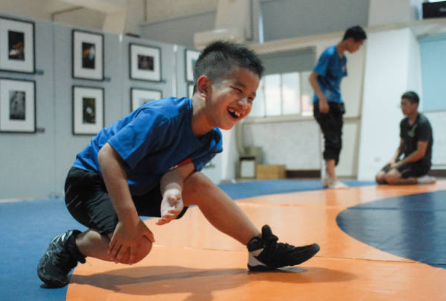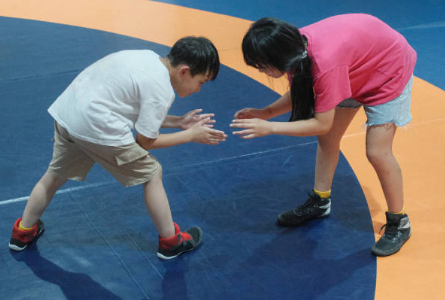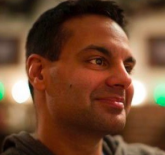Olympic Wrestling: A Barrier-Free Path to Better Youth Fitness

Previously published in Volume 82, Issue 1
The challenge: access to activities
For children, physical activity improves both physical and mental health, and offers a long list of other important benefits. However, 91 per cent of Canadian children and youth do not meet the guidelines set forth in Canada’s Physical Activity Guides for Children and Youth, which recommends 90 minutes of moderate to vigorous physical activity, each day.
There are several barriers that can stand in the way of youth, on their path to increased activity and better health. One possible solution is the increased inclusion of Olympic wrestling in both teacher education curricula, and school and community activity programs. In many ways, it’s an ideal sport thanks to its ability to get past the main obstacles preventing students from participating in physical activities.
Four barriers to physical activity
Currently, physical education is offered in all school systems (both public and private) in Canada and the majority of schools have physical activity programs after classes and on weekends. This should provide ample opportunity for children to participate in physical activity at school, however many choose not to, or are unable to be a part of the programs offered (Copeland et al., 2012, and 2009). Many youths who would otherwise participate in current school and community centre programs face socioeconomic, gender, genetic or fitness-level barriers.
Socioeconomic barrier
Cost is often a factor preventing parents from enrolling their children in sports programs. Some popular sports, like hockey, can cost upwards of $4,000 per season. Just the cost of equipment is a barrier to Canada’s most popular sport, and this excludes registration fees and travel expenses. Government physical education programs often fail to provide access to sports with lower costs, to suit the needs of lower-income families. Low-income families, in turn, often do not have the time to be a part of the sports programs in their communities, and so are not able to inform officials which programs they need for their children. Also, most programs are not conducted on a drop-in basis, so parents of low-income families must pay a large registration fee, even if their children may not be able to attend on a regular basis. Children also fear being teased due to the type of clothes they wear to play some sports (not having the right shoes, etc.), and this may lead them to stop participating (Copeland et al., 2009).
Gender barrier
In our society many sports are labeled as exclusively appropriate for males or females. For example, football is often seen as a male-dominated sport. Often, for fear of injuries, girls and women are discouraged from playing football with boys and men. Thus, administrators are often preventing access to a physical activity for a whole gender. Other individuals may decide, on their own, not to participate in a sport because it is perceived as a “girls’ sport” or a “boys’ sport.” By labeling sports as masculine or feminine, this limits access to physical activity for youths. When physical activities are implemented into school and community centres, this must be taken into account to make the programs accessible to everyone.
Genetic barrier
Participation in popular high school sports is often based on specific genetic factors. Standing 5’10 and taller, for example, has been shown to give participants an advantage in volleyball, basketball and soccer (Barnsley et al., 1988). If youths are taller, they will typically perform better in these sports than their shorter peers. Several studies have shown that if someone performs well in a sport the first time they participate, they are more likely to continue playing the same sport. This applies in other physical activities as well (Kansal, 2010). Therefore, the more skilled youths seem to be in a sport, the more likely they are to continue to participate in these sports and gain the benefits of physical activity.
In addition to genetics, age is also a factor. If an individual is born earlier in the year, they are likely to be taller and stronger than their classmates, and would therefore excel more in physical activities (Parent-Harvey et al., 2014). Having an early birthdate can affect how interested in physical activity an individual will be. If a youth is taller and stronger, they will perform better than their peers and will therefore be more interested in participating in sports more often. To ensure that all youths feel comfortable, a physical activity program should accommodate for the height and strength differences of participants to keep them all interested and involved.
Fitness-level barrier
An individual’s level of fitness prior to participating in physical activity can affect how they feel about participating in that sport. Many youths want to participate in sports, but cannot due to low levels of fitness. Youths with lower fitness levels cannot keep up with those whose fitness levels are higher, and therefore feel self-conscious. Youths may also choose not to participate because of ridicule from others who are solely focused on winning and do not want teammates who hinder the chances of victory. This can create feelings of inadequacy in the unfit youth and will actually hurt the youth’s mental health rather than improve it. Ideally, sports should allow youths to become physically fit through participation, not have fitness as a prerequisite.
In order to increase physical activity, schools and community centres must provide programs that are universally accessible to all youths. The programs must remove the four key barriers and give complete access to all youths in all communities. These barriers prevent youths from having universal access to a proven treatment/prevention method for low levels of mental wellbeing. Restricting youths from taking part in these activities goes against the Canadian Health Act, and instead benefits those who are not affected by some or all of the barriers. A policy change must occur in the school systems to allow for youths to have the option to participate in physical activity. By refocusing on a proactive policy change that is universally accessible to all youths, provincial governments could save millions on future health care costs associated with obesity and sedentary life styles, and give equal opportunity to all residents.

Solution: Olympic wrestling
One answer to the problem of barriers is the sport of Olympic wrestling. It’s inclusion in more after-school programs could lead to more physically active youths, since it gets past all four barriers to participation.
First, it’s a sport with no socioeconomic barriers (Kamble et al., 2015). Youths are not required to purchase any equipment as they can wrestle in any outfit they find comfortable. There is no specific footwear and the singlets that are worn in the Olympics are not mandatory for competitions. The only piece of equipment required is a set of foam mats, and schools across Canada were given these mats back in the 1970s and 1980s.
Gender barriers are non-existent in Olympic wrestling. During practices, boys and girls wrestle each other in a gender-mixed atmosphere. At competitions, girls and boys are separated, but still work as a team to help one another succeed via coaching and peer support. While some may perceive wrestling to be a male-dominated sport, Canada currently has the best women’s wrestling team in the world. Having Canadian women of such a high skill level creates role models, and role models have been shown to increase female youths’ participation in sports (Meier, 2015).
One of the most equalizing components of Olympic wrestling is its use of weight classes. By having wrestlers compete with others of the same weight, genetic barriers are removed. If an individual is taller, he or she will either wrestle other tall individuals or shorter individuals who likely have significant muscle mass. Weight classes make wrestling fair; it is not about how big a participant is, but about how well they wrestle (Pettersson et al., 2013).
Wrestling is a team sport in practice; all individuals train and work together to improve, but compete individually. Wrestling matches occur on a one-on-one basis so there is little pressure to succeed for the team. Participants who start out with a low fitness level can take their time to build up their fitness level without having other members of the team pressure them to keep going for the good of the team (Stevens et al., 2006). This allows the youths time to build up their fitness level without hurting their confidence and also allows them to participate as they feel comfortable.
Sport safety concerns
One of the biggest threats to an Olympic wrestling program is parents not wanting to allow their children to participate in what they consider to be dangerous physical activity. As Olympic wrestling is a combat sport, it is often seen as violent or dangerous with a high likelihood of injury. However, studies have shown that of all sports offered in high schools, wrestling has the fewest injuries (Rechel et al., 2008). Rechel et al. (2008) found that football has the highest number of injuries and concussions of all high school sports. They also determined that boys’ soccer and girls’ basketball have the highest number head, face and neck injuries and the second-highest number of concussions. Even baseball and softball have more injuries than Olympic wrestling due to the repetitive motion of throwing a ball with the same arm. These facts alone suggest Olympic wrestling is extremely safe as compared to other sports considered the staples of schools across the province.
Even youths with disabilities can be active in wrestling. It is an official sport in the Paralympics, and rules exist to allow people with disabilities to participate. Physical education instructors could easily adapt any program to ensure access to those with physical disabilities.
Ultimately, Olympic wrestling breaks through all of the key barriers preventing youth participation and gives those involved all the added benefits of being physically active.
If wrestling was implemented (or re-implemented, where it has been cut) into the physical education teacher curriculum at universities across the country, it would give PE teachers an activity for students that is free of socioeconomic, gender, genetic and fitness-level barriers, and accessible to all youth.
References
Barnsley, R., Thompson, A., & Craig, K. (1988). Birthdate and success in minor hockey: The key to the NHL. Canadian Journal of Behavioural Science/Revue Canadienne Des Sciences Du Comportement, 20(2), 167-176.
Copeland, K. A., Sherman, S. N., Kendeigh, C. A., Kalkwarf, H. J., & Saelens, B. E. (2012). Societal values and policies may curtail preschool children's physical activity in child care centers. Pediatrics, 129, 265–274.
Copeland, K. A., Sherman, S. N., Kendeigh, C. A., Saelens, B. E., & Kalkwarf, H. J. (2009). Flip flops, dress clothes, and no coat: Clothing barrier to children’s physical activity in child-care centers identifies from a qualitative study. International Journal of Behavioral Nutrition and Physical Activity, 6.
Kamble A., & Wangwad V. (2015). Relationship between socio-economic statuses and performance on wrestling players in Solapur University. Indian Streams Research Journal, 5(4), 1-6.
Kansal, D. (2010). A critical study of sports talent selection and promotion of sports participation, at young age. British Journal of Sports Medicine, 44(Suppl 1), I65.
Meier, M. (2015). The value of female sporting role models. Sport in Society, 18(8), 968-982.
Parent-Harvey, C., Desjardins, C, & Harvey, E. (2014). Factors affecting the relative age effect in NHL athletes. Canadian Journal of Surgery, 57(3), 157.
Pettersson, S., Pipping, M., & Berg, C. (2013). Practices of weight regulation among elite athletes in combat sports: A matter of mental advantage? Journal of Athletic Training, 48(1), 99.
Rechel, J., Yard, E., & Comstock, R. (2008). An epidemiologic comparison of high school sports injuries sustained in practice and competition. Journal of Athletic Training, 43(2), 197.
Stevens, W., Butler, J., Cooke, K., & Everitt, R. (2006). Does a Season of Wrestling Practice Change the Fitness of Middle School Boys?: 1493. Medicine & Science in Sports & Exercise, 38(Supplement), S214.
Tousignant, M., Vitenti, L., & Morin, N. (2013). Aboriginal Youth Suicide in Quebec:
The Contribution of Public Policy for Prevention. International Journal of Law Psychiatry, 35(5-6), 399-405.









